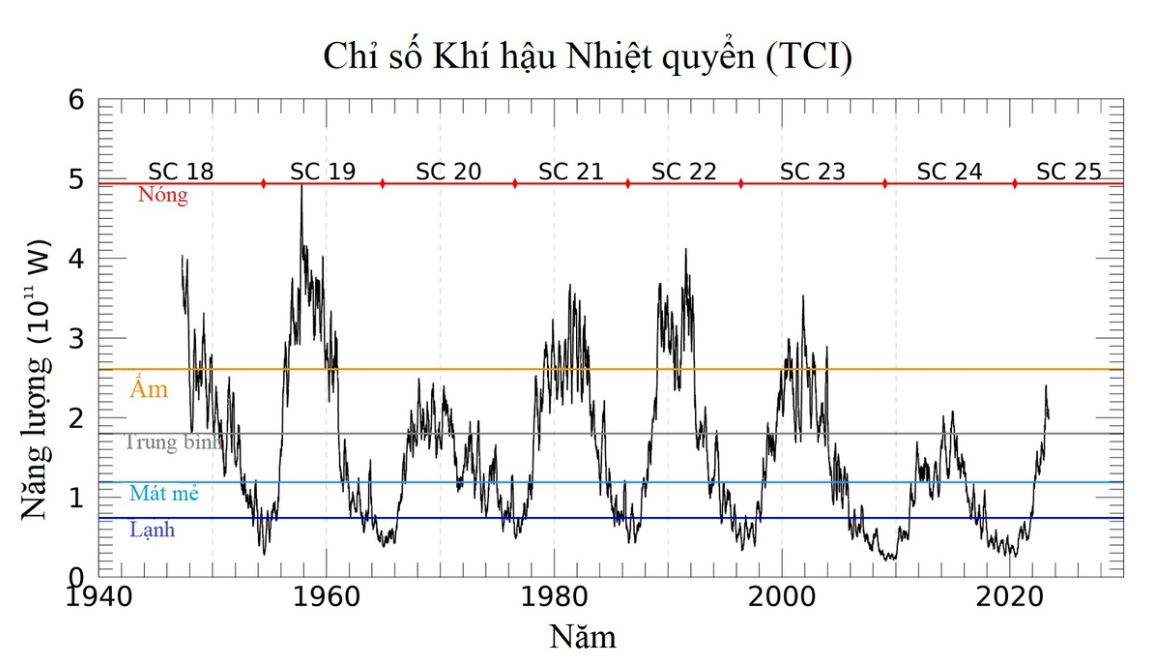A series of geomagnetic storms have caused atmospheric temperatures to spike this year, suggesting that solar maximum is approaching.
The thermosphere reaches peak temperatures due to geomagnetic storms. Photo: Aphelleon/Shutterstock
The thermosphere – a vital part of the Earth’s atmosphere – recently reached its highest temperature in nearly 20 years. Experts warn that temperatures in the thermosphere could continue to rise in the coming years as solar activity increases. This could affect artificial satellites orbiting the Earth.
Temperature spike
According to NASA, the thermosphere extends from the top of the mesosphere (about 85 km above the ground) to the bottom of the exosphere (starting about 600 km above the ground).
For more than 21 years, NASA has been measuring the thermosphere temperature using infrared radiation emitted by carbon dioxide and nitric oxide molecules. Scientists have converted the data collected by NASA satellites into the Thermosphere Climate Index (TCI), measured in terawatts (TW). 1 TW is equivalent to 1 trillion watts.
Thermosphere Climate Index from 1940 to 2020. Photo: NASA Langley Research Center. Vietnamese translation: Kim Yen
“The TCI spiked on March 10, 2023, peaking at 0.24 TW. The last time the TCI was this high was on December 28, 2003,” said Martin Mlynczak, a researcher at NASA’s Langley Research Center.
The spike in temperatures was caused by three geomagnetic storms in January and February, Mlynczak said. These storms contained solar wind and coronal mass ejections (CMEs), which caused extreme disturbances to Earth’s magnetic field. Normally, the infrared radiation after a storm cools the thermosphere, but when the storms returned, temperatures remained high.
In 2023, at least two geomagnetic storms will hit our planet. The storm that occurred on March 24 was the strongest solar storm to hit Earth in more than 6 years. A month later, another equally strong geomagnetic storm hit Earth.
Geomagnetic storms are more frequent and intense during “solar maximum”—the part of the roughly 11-year solar cycle when the Sun is most active, producing CMEs and solar winds. As a result, the warming of Earth’s thermosphere follows a roughly 11-year cycle.
Harmful to satellites
Mlynczak said changes in the thermosphere could be harmful to satellites operating in the vicinity.
A warming thermosphere could cause satellites to collide with each other or veer off course. Photo: Johan Swanepoel/Shutterstock.
“The thermosphere expands as it heats up, increasing the aerodynamic drag on satellites, pulling them closer to Earth. This can cause satellites to collide with each other or fall out of orbit altogether, as happened with SpaceX’s Starlink satellites in February 2022,” Mlynczak explained.
To avoid this problem, satellite operators can move the spacecraft to a higher orbit. However, it is difficult to calculate exactly when this should be done.
Scientists at NASA and NOAA predict the next solar maximum will occur in 2025, indicating that the warming trend could continue for several years. However, it could also occur earlier, as late as 2023, according to a study published on January 30 in the journal Frontiers in Astronomy and Space Science. If this scenario occurs, the risk of satellite disasters increases.
According to Zing
Source






![[Photo] General Secretary To Lam chairs the 14th Central Military Commission Conference](https://vphoto.vietnam.vn/thumb/1200x675/vietnam/resource/IMAGE/2025/6/20/a9d25fc6dd664fb9a3757502f32e5db0)



![[Photo] Panorama of the Opening Ceremony of the National Press Festival 2025](https://vphoto.vietnam.vn/thumb/1200x675/vietnam/resource/IMAGE/2025/6/20/6b835ee92c2c4df587af73cb2d1f4f5f)












































![[Maritime News] Wan Hai Lines invests $150 million to buy 48,000 containers](https://vphoto.vietnam.vn/thumb/402x226/vietnam/resource/IMAGE/2025/6/20/c945a62aff624b4bb5c25e67e9bcc1cb)















































Comment (0)